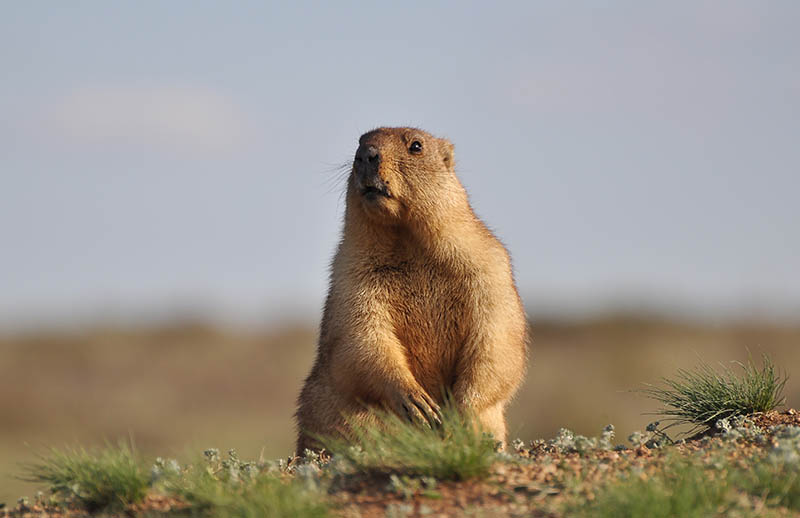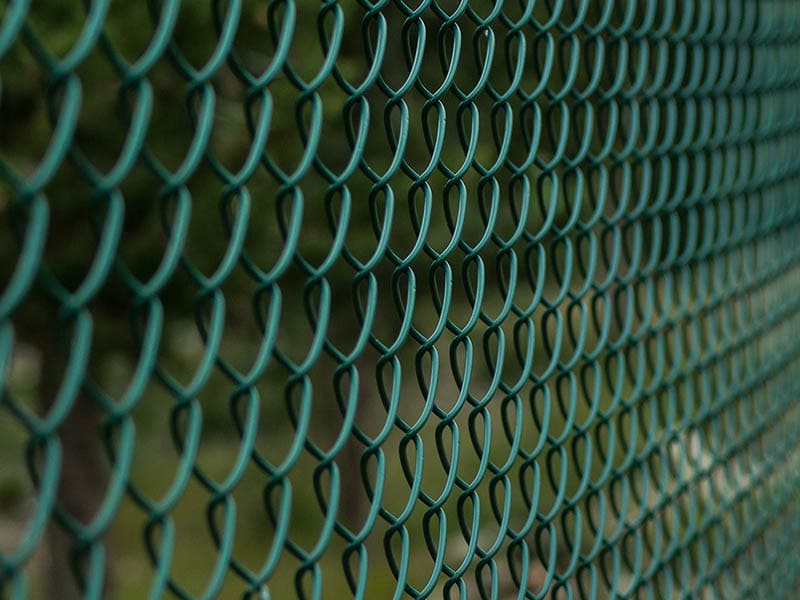How to Get Rid of Groundhogs in Your Yard (12 Useful Tips)
-
- Last updated:

Groundhogs might look funny and cute, but when they invade your yard, keeping them away turns into one big quest. Fast, energetic, and with sharp teeth that can cause structural damage to your house, these relentless rodents dig burrows, chew on stumps, and ravage entire gardens within days. Fortunately, woodchucks can very well be dealt with.
As long as you know how to block, trap, scare, and lure them away, you’ll be able to protect your land from the invaders. Now, after successfully fending off a group of groundhogs, our experts put together a list of the 12 most practical, actionable, and easy-to-use remedies against them. Ready to bring peace back into your backyard? Let’s get it done!
Content covered in this article:
- What You’ll Need for the Job
- Ways to Get Rid of Groundhogs in Your Yard
- Why Keep Groundhogs Away?
- Are Groundhogs Aggressive? Do They Spread Diseases?

What You’ll Need for the Job
There are quite a few things you can try to turn your property into a groundhog-repelling fortress. The cheapest way to do that is to sprinkle some hair, pet urine, garlic, or oil around the perimeter. The more reliable solutions include using traps, building a fence, and investing in solar stakes. Here’s what you’ll need to get this done swiftly and without killing the woodchucks.
| Tools Required | Materials/Products Needed |
| Mesh wire (for the fence) | Castor oil/Epsom salt |
| Groundhog traps | Cat/dog litter or urine |
| Motion-detection sprinklers | Pepper or garlic |
| Solar powered stakes | Hair/fur clippings |
| Chainsaw + spade | Commercial repellent |
| Work gloves | Crushed stone |

The 12 Ways to Get Rid of Groundhogs in Your Yard
1. Build a Tall Wire Fence

Physically blocking access into the yard is one of the most effective solutions against any critters. While it won’t be exactly cheap, the fence will stay up for years, making it a worthy investment. The most important thing to remember when building a fence is to make it high; otherwise, the groundhogs will climb over it. Aim at 3–4 feet and bend the top of the fence outward a bit.
As for the lower half, at least one foot of the fence should be buried into the ground and then bent at a 90-degree angle (again, twist it outward). This way, when the woodchucks decide to dig a burrow to cross into your property, the fence won’t let them through. You could also try and electrify the fence, but that will probably injure the groundhogs and put your kids and pets at risk.
2. Put Traps Around the Perimeter
If you’re not yet ready to build an entire fence, you can just use row covers to secure the crops. But that’s only a temporary solution. Instead, consider placing groundhog traps around the property. To answer your question, no, these traps won’t hurt the animals in any way. They are used for luring the critters inside, moving them to a faraway location, and then releasing the trespassers (at least 5–10 miles away from the yard).
Do check the local laws before you do that, though, because, in some states/cities, it might be illegal to do that—only a professional is allowed to handle the issue. Besides, they’ll know exactly where to relocate the woodchucks. In any case, do this in the early days of spring (late winter will also do). That’s when the snow will melt and reveal the burrows.
3. Use Castor Oil or Epsom Salts

Woodchucks can’t stand the smell or the taste of Epsom salts. So, if you sprinkle a generous amount right in front of a burrow entry/exit, that will keep the critters discouraged for a long time. Plus, many gardeners put these salts near the most precious plants and flowers in the garden to prevent groundhogs from feasting on them. Castor oil is a great alternative to Epsom.
The concept is identical: you just put some around the tunnels and let Mother Nature do the rest. However, for the best results, you should only do this when the groundhogs are not inside the burrows. Otherwise, they’ll just stay hidden in there. Oh, and no need to worry: these products are 100% natural and won’t harm the intruders. Give lime and talcum powder a try as well.
4. Pepper and Garlic
Don’t have any fancy oils and salts around the house? That’s okay! You can always use some dried garlic, lavender, or pepper instead. Only this time, try spreading it not only around but also inside the burrows. If this proves to be a tedious task, put the pepper inside of a spray bottle, mix it with water, and apply it that way. But wait—can you spray this formula directly onto flowers and veggies? The answer is yes!
5. What About Kitty Litter?

Did you know that cats and dogs are primary predators of woodchucks? That’s right, and you can use this to your advantage. Now, if you sprinkle some cat urine or used litter around the burrows, that will make them leave your property. The downside to it is that over time, the smell will wear off, forcing you to repeat the process. But it is inexpensive and takes 5–10 minutes to do.
6. Hair Clipping to Scare Them Off
Not too happy about putting kitty litter to work? Then try spreading some hair clippings instead. These can come from your pet cat, dog, or even a human. If you don’t have enough hair to cover the entire property, ask a local barber to hand you over their hair clippings. Groundhogs dislike human odors and will leave the area once they smell them.
Yes, the idea is the same as with urine—we use the smell as a natural repellent. A quick note: spreading hair at the spots where the woodchucks hang out is a good plan, but only if you put it in mesh bags. Otherwise, the wind will scatter the hair clippings all over the property, which is NOT what you want.
7. Sprinklers to the Rescue

You can buy a motion-activated sprinkler for $50–$60, and while it won’t be able to cover the whole yard, if you place a couple of these devices strategically, the results will be quite impressive. Here’s how it works: when the second a sprinkler detects motion, it automatically switches on and “hits” the critter with water. That should be enough to scare it away.
The only downside—you can’t program the machine to only attack groundhogs. They’ll be triggered by cats, dogs, children, and adults as well. The solution is to put the sprinklers away from the areas that you visit frequently. Placing them around the perimeter, closer to the fence, is a great place to start. Or try installing at least one motion-activated sprinkler right next to your veggies or flowers.
8. Give Commercial Products a Try
Groundhog repellents that they sell at local stores are based on a synthetic compound specifically formulated to scare critters away. Some products drive the troublemakers away with the taste; others rely on the smell. So, read the instructions first to learn how to use the product properly. Critter repellents are available in liquid and granular form and need to be reapplied after it rains.
For the most part, these formulas do work, and they’re generally worth their price. That doesn’t mean you won’t be able to solve the issue without them, though. Besides, if the woodchuck population in your area is big and strong, you probably won’t be able to keep them out for good unless you build a fence and/or place traps around the perimeter.
9. Seal the Woodchuck Tunnels

Also known as burrows, these holes in the ground help them move around efficiently and stay away from the “prying eyes” of natural predators. Therefore, if you block these holes, that will keep the woodchucks away. Now, you might think that putting a little bit of dirt in there will do the trick, but most critters can dig through it easily. Instead, fill the holes with crushed stone.
Fumigating the burrows is also an option, but you’ll need a specialist to do that, and it won’t be cheap.
10. Make Them Starve
If you’re having a hard time keeping groundhogs away, that could be because they’re attracted to certain plants/weeds that grow on your property. Groundhogs don’t like anything too fancy: they are big fans of common lawn weeds like clover, alfalfa, and dandelions. Carrots, corn, apples, and berries are a part of their daily ration as well. Bush piles and tall grass, in turn, are often used as hiding spots.
Woodchucks need to store enough fat before they hibernate. During hot summer days, a groundhog eating mulberries or maple leaves is a common sight. Sometimes, they even feast on grasshoppers and snails; but they prefer weeds, vegetables, and fruits. What you can do here is move some of the woodchuck-favored weeds to a different location, thus taking the “heat” off your property.
11. Leave No Stump or Leaf Pile Standing

Don’t forget to remove the tree stumps. Groundhogs can’t go on for long without sharpening their teeth. So, if they see a stump in the yard, they’ll come back later to chew on it. Even if it’s a really small stump, you should still get rid of it. Just like any other rodent, a groundhog will find a way to chomp on it. This is especially true if the stump is surrounded by their beloved weeds.
Contractors charge quite a lot for handling stumps. To do that manually, you’ll need a chainsaw, drill, and chemical remover. Also, do your best to remove any nesting opportunities from the yard. We’re talking about leaf piles, pieces of wood sitting on top of each other, and garbage. By keeping the lawn short and the shrubs trimmed, you’ll give groundhogs fewer reasons to stick around.
12. Use Ultrasonic Pulses
And what about putting some fear into the hearts and minds of the woodchucks? No, we’re not talking about installing pinwheels or scarecrows all over the yard. Instead, try using something different, like solar sonic pest-repelling stakes that make the ground vibrate by generating ultrasonic pulses. This is a non-harmful way of keeping groundhogs and many other critters or pests away.
But is it effective? Well, if you keep at it, these furry animals will, eventually, stop digging tunnels in the area. However, the outcome might not be what you’d expect. Sometimes, the pulses force groundhogs to go deeper into your territory. In other cases, they’ll switch to a neighbor’s property.

Why Keep Groundhogs Away?
The main reason why these animals are not welcome in a garden is that they eat and damage plants, vegetables, and even fruit that grow high up on the trees (yes, groundhogs are decent climbers). On top of that, groundhogs often “chew” on sheds, barns, containers, house foundations, furniture, and pretty much anything else that their teeth can handle.
They’re also known to carry some diseases (we’ll talk about that in a moment), and if you fall into a woodchuck tunnel/hole, you could end up with a twisted ankle or something worse. These tiny animals spend a lot of time digging burrows that can be as long as 50 feet. So, how do you spot their presence? Look out for 10–12-inch-wide holes in the ground. Half-eaten fruits and veggies are another sign.

Are Groundhogs Aggressive? Do They Spread Diseases?
For the most part, no, woodchucks don’t show any aggression towards a human or a pet unless they’re provoked. So, unless you’re posing a threat to the babies of an angry groundhog, there’s very little to worry about. Besides, if you come across this rodent in your backyard, most likely, it will just run away. To put things into perspective, groundhogs are smaller than raccoons.
The average size for a male is 13 pounds and 18–20 inches. During the winter, they hide in burrows and hibernate until the cold days arrive. That said, groundhogs can have rabies, and that’s when they become dangerous. So, if you ever get bitten, do your best to get some PEP shots ASAP. That will stop the disease from spreading. Here’s a quick look at the diseases spread by woodchucks:
- Rabies
- Hepatitis
- The Powassan virus
- Lyme and Tularemia
- Ticks and fleas

Conclusion
Groundhogs are found in many American states. They range from the cold mountains of Alaska to the humid meadows of Alabama. Usually, these rodents hunt in groups and build intricate burrows that allow them to quickly navigate through the area, hide, and find food. And if you have a garden in the backyard, best believe the woodchucks have already set their eyes on it.
The good news is—while they can be a nuisance, there are certain non-lethal steps you can take to keep them away. Today, we covered the most effective, long-lasting, and affordable solutions against a groundhog attack. Even if you implement half of these remedies, that will make the critters think twice before they invade your yard!
- Edu – Managing Woodchuck Problems
- Edu – Preventing Groundhog Damage
- Com – How To Get Rid Of Groundhogs Humanely
- Ca – Living With Wildlife, Groundhogs
- Matec-Conferences.Org – The Use Of Human Hair
- Gov – Rabies Postexposure Prophylaxis (PEP)
- A-Z-Animals.Com – Are Groundhogs Dangerous?
- Ca – What Do Groundhogs Eat?
- Com – Does Cat Litter Keep Mice Away?
- Edu – Castor Oil
- Com – Deter Groundhogs
- McGill.CA – Mammals, Groundhogs
- Com – Groundhog
- Com – Fumigation
Featured Image Credit: YevgeniyDr, Shutterstock
Contents

